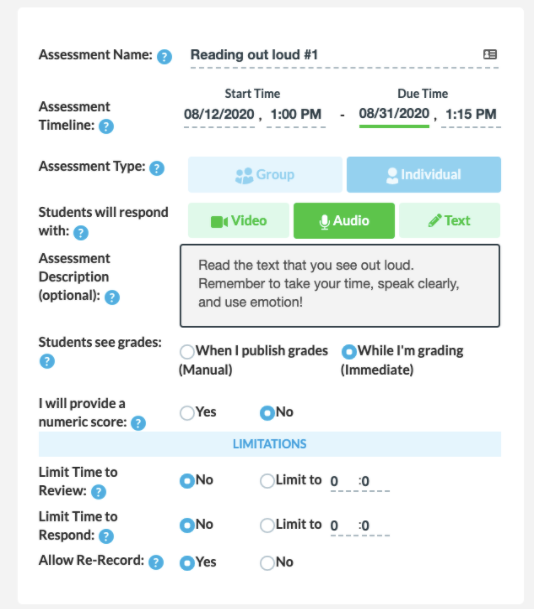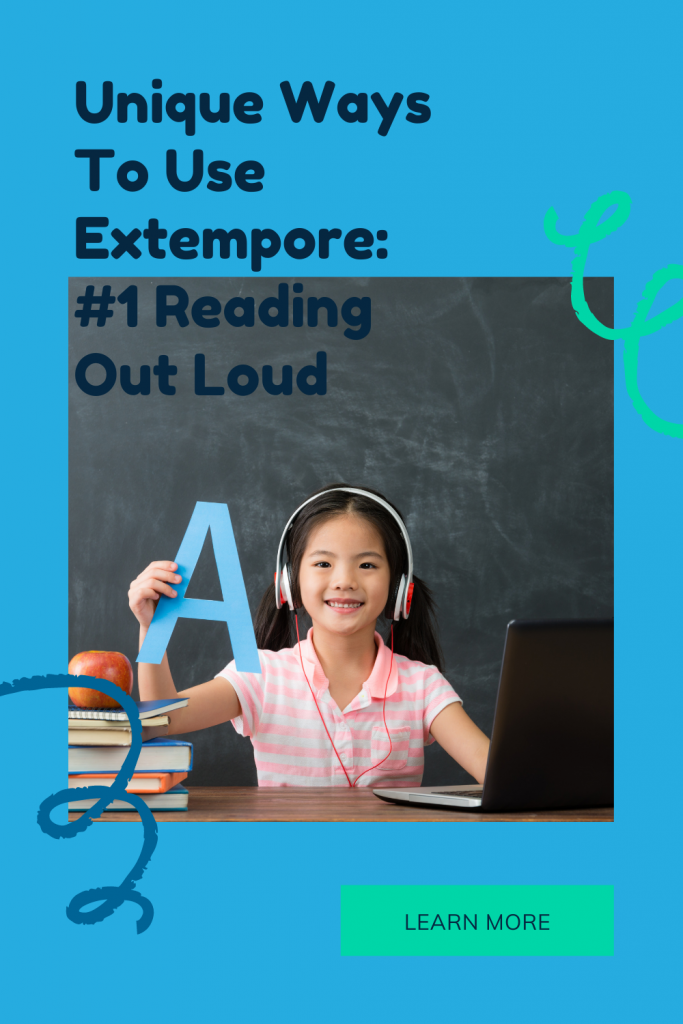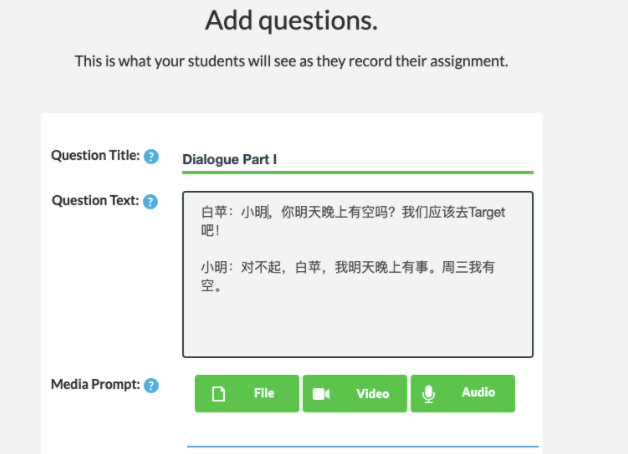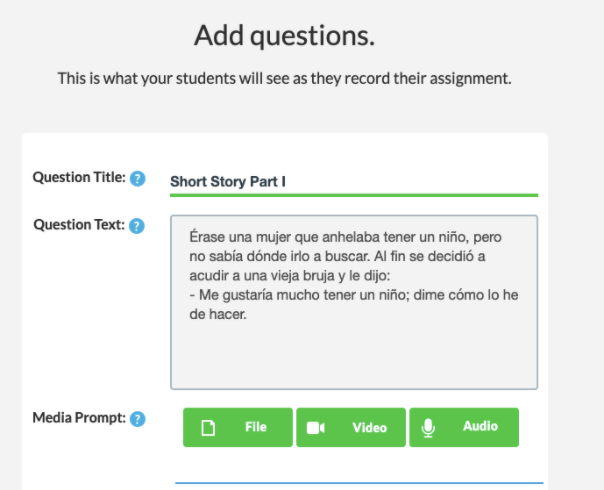
So simple yet often overlooked, reading out loud (‘oral reading’ in academic parlance) carries countless benefits for learners of second languages. Not only can students show comprehension by how they read the text, but teachers (like you) will know how well students grasp the language’s phonology and cadence. On top of this, reading out loud is tremendously helpful for learners of languages with non-Latin scripts, like Arabic, Russian or Hebrew, or for learners of character-based languages, like Chinese or Japanese. Even for languages that are based on the Latin script (or other native scripts), reading out loud can build learner confidence and improve language delivery. By reading out loud, learners are forced to hear themselves pronounce the language and connect symbols to sounds, while also understanding the context of the text. Try it on this paragraph and see if you would make a good audiobook reader!
Through consistent repetition, oral reading reinforces a language’s sound-symbol pairings, slowly ingraining them in your students’ minds. As a Mandarin language teacher, I take time in all of my classes (in class and on Extempore outside of class) for this type of literacy practice. It’s an imperative skill for novice levels, where nearly every new word means a new character (or sometimes two or three). Thus, with comprehension so dependent on character recognition (and connecting characters to sounds), reading out loud is a must for my classes.
No matter the level, students can greatly benefit from reading out loud. Now the bigger questions — what should students be reading? And how do we do this on Extempore?
Novice levels — Basic dialogues + short paragraphs
For novice levels, stick with basic dialogues and short paragraphs of text. At the early levels, too much text can be overwhelming and place unnecessary pressure on beginning students. At the same time, don’t have students sight read individual words; focus on texts that are meaningful and align with your learning targets and objectives. The right length text will have familiar language yet still be long enough to challenge students to read fluently. See examples below for Spanish and Chinese.
Spanish
Jorge: Margarita, ¿qué tal?
Margarita: Hola, Jorge! Estoy enferma, no voy a la escuela hoy.
Jorge: Pobrecita!
Chinese
小明:白苹,你今天怎么样?
白苹:我今天很好啊,你呢?
小明:我也很好。我得走了。再见!
Intermediate levels — longer dialogues + paragraphs
For intermediate levels, use longer dialogues and paragraphs. Again, the important thing is to integrate language and structures that are familiar to students (that is, those covered in recent classes or have already been learned). A good rule of thumb: the more familiar students are with the language, the longer* your text can be. Lengthier texts can be daunting at first (“But Mr. Castner, it’s SOO LONGG!!!”), but remind your students to take their time and read at their own speed. Often, students will feel a strong sense of accomplishment from completely reading a long passage out loud and by themselves.
Spanish
Jorge: Buenas tardes, Margarita. Qué haces este fin de semana?
Margarita: Hola, Jorge! Voy a la casa de mi novio; nosotros vamos a visitar a su familia extendida. Y tu? ¿Qué planeaste hacer?
Jorge: Yo no planeé nada. ¿Cómo se llama tu novio?
Margarita: Él se llama Carlos. Estas chistoso?
Chinese
小明:白苹,我们去吃饭吧!
白苹:好,在哪里吃啊?我听说附近有快餐店,我好想吃辣肉面!
小明:哎,我前天在那里吃了午饭,面又咸又贵!我不吃。
白苹:好,那你可以一个人吃午饭,怎么样?
小明:白苹,不要这样!
* what “long” means is entirely up to the instructor. It could mean an eight-line dialogue instead of four, or three paragraphs instead of one. As such, a “lengthy” text is totally subjective and its definition is at the discretion of the instructor.
Advanced levels — Dialogues and paragraphs of appropriate difficulty, and an extra challenge
Reading out loud provides advanced students a chance to see how well they can read fluently, emphasizing proper speed (it’s not a race!) and pronunciation. For these students, there is flexibility on what type of texts to use. To choose what would be best for your students, focus on your current unit content and objectives. As an added challenge, encourage students to give their own opinion on what they read. For example, in the examples below, ask your students to judge the interviewees responses using the target language and relevant vocabulary. Ask your students: “How might you respond to these interview questions?” “What advice would you have for the interviewee?” They can respond to these questions once they have finished reading, adding an extra level of comprehension and analysis.
Chinese
Using Timers on Extempore for reading out loud
For most oral reading assignments, it’s best to refrain from using timers. Just like texts that are too lengthy, timers can also place unneeded restraints on students and thus negatively impact their performance. Removing timers allows students to comfortably read the text at their own pace. If you do choose to use timers (as I have for character recognition assessments), be sure that students are very familiar with the text and vocabulary at hand, and make sure the allotted time will account for the different reading speeds among your students.

You can split dialogues or narratives into sections (each section a different ‘question’ on Extempore) to allow students to focus on one exchange at a time.
Encouraging students to use emotion and proper tone (especially with dialogues)
There is one other factor of oral reading that touches on a seldom mentioned aspect of language learning. Reading out loud provides a perfect outlet for an added element—using emotion. In the few years I’ve been teaching, I’ve found that encouraging students to emote and play the part of the characters often keeps them more engaged and allows them to better illustrate their comprehension. Remind students that monotone reading is a) outright boring and b) extremely uncommon in everyday speech. Authentic language will almost always have emotion, variance in speech, and even filler words like “uh,” “well," and “like” (at least for English). If Luisa tells Señor Alvarez that her dog is sick and can’t come to the party, then she should sound sad. Likewise, if Jean just got admitted to the University of Paris, he should sound excited and not like he just woke up. Equally important is to tell your students to be mindful of punctuation like question marks and exclamation points. Questions should be read like questions, and exclamations like exclamations! Clear? Clear! (Hear the difference in your head?) Don’t let your students forget this (or get away with it!). By emphasizing the need to use emotion, you force students to understand the context of what they are reading and manipulate their voice to reflect that understanding. This is just one reason why I love using dialogues for reading out loud: students have to know each speaker’s role in the conversation and how he/she will respond and react to what is said.
Okay, we’re ready to read! Before we assess our students’ reading though, let’s recap how to best prepare these oral reading assignments.
- Gear your texts to your students’ level and align them with your objectives. For advanced students, add in an extra element like judging a speaker’s response or giving advice to a character in the text (upon finishing reading, of course).
- If necessary, break up dialogues / texts into sections (different ‘questions’) on Extempore to lighten the cognitive load on your students. This also helps with pacing longer texts.
- Try not to use timers unless you are sure that 1) you want to assess your students and 2) they are ready to be assessed.
- Encourage students to use emotion when reading and to go at their own pace. High quality reading is not fast!
Assessing reading out loud
In properly prepared oral reading assignments, there are many areas of language learning that you as an instructor can assess. Here are a few that come to mind.
- Cadence, emotion, and tone. Earlier, I talked about the importance of students using their voices to reflect what they read. Once students are comfortable with reading out loud tasks on Extempore, language instructors can even use these assignments as alternatives for typical comprehension questions. Any question related to feelings, tone, and audience can easily be replaced by listening to how your students read the text. In my own experience, students enjoy this change of pace. You could even have them compete and see who can be the best audiobook reader of two paragraphs of Le Petit Prince, or who can best individually act a scene using a script from a popular telenovela.
- Pronunciation and phonological awareness. Yes, this is the most obvious one, but that doesn’t mean it’s not important! In the many instances where I have used Extempore for reading out loud tasks, I’ve found that student results reveal a ton about their grasp of the language’s sounds. When students pronounce basic Mandarin words like 是shì as ‘she’ 有yǒu as ‘yao,’ or 吃chī as ‘chee,’ I know I need to take time in class to correct these errors. Likewise, reading out loud can shed light on students’ phonological awareness. One common example is found in ESL classes. English has dozens of words with different possible stresses and thus different meanings. Consider the examples below:
- “Ramona will present the present she got for the class.”
- “Ms. Luzardo was not content with her teaching content.”
- “Don’t desert me in the desert!"
I know, I know, we almost never see sentences like this, but when read aloud, the speaker has to know the context and when these italicized words change stress. That’s phonological awareness.

- Character recognition and reading of non-Latin scripts (or a non-native script). In my Mandarin classes, I always have simple reading quizzes at the end of larger lessons (usually every two weeks pre-covid) to ensure that my students know how to pronounce the characters we learned and are ready for new characters. Students will read a dialogue with pinyin (latin letters that represent sounds of Chinese characters) only on bonus words (if they choose to read completely without pinyin I give them a bonus point), and I assess them on fluency, character recognition, and emotion. If you teach a language that uses a non-Latin script (or a different script from that of your students’ native language) or a character-based language, reading out loud tasks on Extempore provide a simple and reliable way to gauge your students’ reading proficiency. For novice students of these languages, reading out loud is imperative for future success.
Using reading results on Extempore to guide your language class
One of the most valuable parts about oral reading assignments is what your student responses immediately reveal. When students read out loud properly, it can signal full comfort with the language, context comprehension, and mastery of non-native script or characters. Conversely, low-quality student responses may be a sign of insufficient practice, misunderstanding of the target language phonology, or L1 interference. In this case, use student mistakes to create review lessons or even just a small warm-up for your students. If an error is common enough, I’ll be straightforward with my students in the next class: “Hey guys, on your Extempore reading last night, a lot of you mispronounced the character 是. Who can tell me how we properly say this?” Have formative assessments throughout subsequent classes to reinforce proper pronunciation, and consider sneaking the word or phrase at hand into relevant tasks in your class. If you are in the classroom, consider using the target word as an “entry password,” where only proper pronunciation of the word in front of the instructor (you, at the door) will grant them access to the classroom (for increased student aggravation, make them say it 4-5 times). As we all know, mindful repetition plays an important role in language learning. Repeated reading practice on Extempore can lead to greater comfort with the target language, increased confidence, and the end goal of all language students: proficiency.
Need help on creating reading aloud tasks on Extempore? Not sure how to use this in your target language? Contact me anytime at grant.castner@extemporeapp.com.






